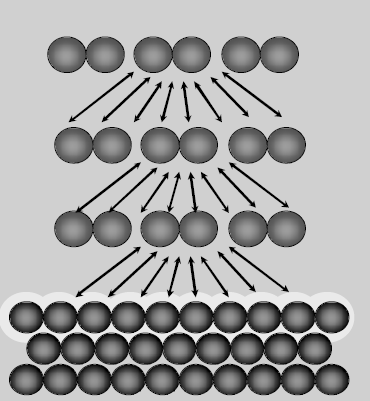Surface Chemistry: Adsorption
Physisorption
Surface Science is the study of physical and chemical phenomena that occur at the interface of two phases such as solid-liquid interfaces. Adsorption is a surface phenomenon in comparison to absorption, which is a bulk phenomenon. A molecule present in the interior of solid (or liquid) is pulled by other molecules from all sides and the net pull on the molecule is zero, but a molecule at the surface experience a resultant downward pull. The concentration of adsorbed molecules is more on the surface in comparison to absorption where the concentration is the same throughout. Therefore, adsorption is left with unsatisfied or unbalanced forces and therefore it has a tendency to attract and retain the molecules of other substances on its surface. Desorption is the removal of bound molecules from the surface (opposite of adsorption)
The adsorbent is the solid substance on the surface of which adsorption occurs is known as adsorbent. Examples include catalyst surface, activated carbon, alumina Adsorbate is the substance which gets adsorbed on a solid surface is called adsorbate. Examples include nitrogen, hydrogen, carbon monoxide, water. Sorption happens when both adsorption & absorption take place, the term sorption is used. Occlusion is the adsorption of gases on the surface of the metal is called occlusion. Coverage is a measure of the extent of adsorption of a species onto a surface while the exposure is a measure of the amount of gas the surface had been exposed to ( 1 Langmuir = 10-6 torr s)
Generally, a molecule that is physisorbed has the bond energy less than 10 kcal/mole. For instance, the gas molecules adhere to the surface of the solid adsorbent as a result of intermolecular attractive forces (van der Waals forces) between them. Weak and long-range bondingsuch as Van der Waals interactions (e.g. Londondispersion, dipole-dipole)is involved in physisorption. The process is exothermic: the heat liberated is in the order of the enthalpy of condensation of vapour (5-50 kJ/mol).The process is reversible (recovery of adsorbent material or adsorbed gas is possible) by increasing the temperature or lowering the adsorbate concentration. More of gas is adsorbed when pressure is increased as the volume of the gas decreases (Le–Chateliers’s principle) and the gas can be removed by decreasing pressure. Since the adsorption process is exothermic, the physical adsorption occurs readily at low temperature and decreases with increasing temperature.
The amount of gas adsorbed by a solid depends on the nature of the gas. In general, easily liquefiable gases (i.e., with higher critical temperatures) are readily adsorbed as van der Waals’ forces are stronger near the critical temperatures. Physical adsorption usually is directly proportional to the amount of solid surface area. This is the reason why finely divided metals and porous substances having large surface areas are good adsorbents. And the adsorbate can be adsorbed on a monolayer or a number of layers where the adsorption rate is generally quite rapid. Physisorption happens between molecules on any surface given that the temperature is low enough. Hence, it is not surface specifically for a particular reaction. Because physisorption is a weak interaction, physisorbates have low desorption temperatures. Formation of physisorbatesis important in chemical reactions where they may act as precursors to chemisorption.

Fig 1:Multilayer physisorption.